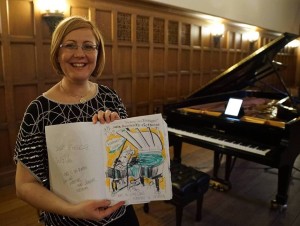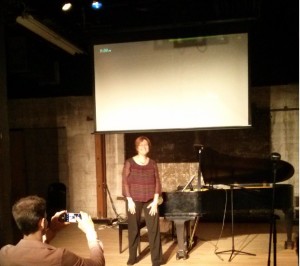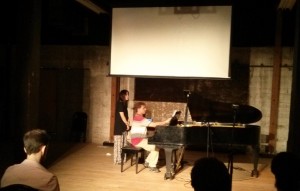 Saturday afternoon, July 23, 2016 and a fine weekend crowd braved the heat and smoke of downtown Los Angeles to gather at Art Share LA for a generous helping of piano music presented by Sound and Fury Concerts. Grammy-nominated Nadia Shpachenko was the featured performer, with Christine Lee and Christian Dubeau also on hand to perform original works. Spanning some two hours, the concert included solo piano pieces as well as works incorporating various forms of electronic accompaniment and images projected overhead.
Saturday afternoon, July 23, 2016 and a fine weekend crowd braved the heat and smoke of downtown Los Angeles to gather at Art Share LA for a generous helping of piano music presented by Sound and Fury Concerts. Grammy-nominated Nadia Shpachenko was the featured performer, with Christine Lee and Christian Dubeau also on hand to perform original works. Spanning some two hours, the concert included solo piano pieces as well as works incorporating various forms of electronic accompaniment and images projected overhead.
Crystal Glass (2015) for piano and electronics, by Christine Lee opened the program, performed by the composer. This began with a strong, sharp sound from the keyboard that was picked up by the electronics and reverberated over several seconds before decaying into silence. More piano notes followed, multiplying and cascading agreeably outward in an active wash of sound. At times Ms. Lee would pluck the strings of the piano, generating softer electronic sounds that, along with some conventional chords, gave an appealing variation to the texture. There was bold, futuristic feel to all of this, but never aggressive or intimidating. As the piece continued some high electronic pitches suggested breaking glass and a series of upward chords added a bit of tension. Strong rumbling in the lower registers alternated with softer stretches but eventually the room was filled with powerful electronic sounds that increased with great energy and dynamism, finally fading at the finish. Crystal Glass strikes a good balance between electronics and the piano, incorporating the new and the familiar in just the right proportions to effectively impart both the futuristic and the profound.
Four Preludes (2016) for piano and electronics, by Christian Dubeau followed, also performed by the composer. Four Preludes represents the first of twelve such pieces, all inspired by the geography and history of the San Gabriel mountains. The first of these was influenced by the rivers and streams of the area and began with lively opening chords that gave way to a quieter and more fluid melody. This had a familiar, organic feel and featured a strong counterpoint in the lower registers. Variations followed, full of flowing phrases that built into a stronger current of sound – much as a river grows from the streams feeding it.
The current drought was the subject of the second Prelude and this featured continuous flute-like electronic sounds, suggesting a dry wind. This had a restless, circling character only partly offset by the sound of a light rainfall in the electronics. This faded quietly away at the ending, leaving the outcome of our continuing drought painfully uncertain. Prelude 3 was inspired by a particularly destructive flood in the 1930s and here the watery feel of the opening returned, but with greater power and movement. There was a majestic sense to this and a surging, rolling feel that nicely evoked the uncontrolled flow. A great descending run of piano keys effectively completed the picture at the finish. The fourth Prelude was inspired by a landslide and this began with the sound of a heavy rainfall in the electronics accompanied by a softer tinkling of notes in the piano that added to the wetness. The rainfall continued and seemed to gain intensity as the piece continued, ultimately including great claps of thunder. Quieter notes and chords were heard from the piano, as if to accentuate the severity of the rainfall. The rain and music continued to spiral out of control, and you could sense that the water was getting deeper by the finish. Four Preludes creates an intimate picture of a place we mostly view from the freeway – the balance of this series should prove equally intriguing.
After an intermission, Nadia Shpachenko took the stage to perform the balance of the program, titled Quotations and Homages. The first work was 6 Fugitive Memories (2015) by Vera Ivanova, for solo piano. Each of the six sections comprised a tribute by Ivanova, as she explained in the program notes: “I decided to remove my compositional style and instead recall through quotations and allusions the pieces of composers to whom each miniature is dedicated.” Composition No. 1, the first, quotes a work of the same name by Galina Ustvolskaya, and this began with a tremendous keyboard crash followed by a series of sinister-sounding notes and then more crashes. The feeling was both dramatic and ominous as loud passages alternated with quieter stretches for this very demonstrative opening. Fugitive No. 2, after Sergei Prokofiev, provided more expressive drama with an active line that featured fast runs and short, rapid phrases at the finish. This contrasted nicely with the third section, No “N”, a portrait of Morton Feldman, and this was a more stately and introspective interlude with softer chords that conjured a feeling of quiet solitude.
Strong, declarative notes began “Quasi una ciaccona”, dedicated to Sofia Gubaidulina, and this had a dance-like feel, as quoted from her Chaccone. The elegant and sophisticated melody suggested a convivial nightclub atmosphere. Cimbalom Játék followed, after György Kurtág, who often used the cimbalom in his compositions. Here Ms. Shpachenko alternately struck strong chords on the keyboard and reached into the piano to tap on the strings with a soft mallet, approximating the mysterious and quiet sound of the cimbalom. Debutie completed the set and was dedicated to both Claude Debussy and Éric Satie. The relaxed, impressionist feel of this final section was instantly recognizable and rounded out this artful exploration of compositional styles. 6 Fugitive Memories is a remarkable exposition of historical and influential musical voices, expertly realized by Ms. Shpachenko.
Rainbow Tangle (2015), by Tom Flaherty was next, scored for piano and electronics and inspired by Messiaen’s Quartet for the End of Time. As Flaherty explained in the program notes: “The otherworldly ecstasy of the opening of it’s seventh movement, “Fouillis d’arcsen-ciel, pour l’Ange qui annonce la fin du Temps (“tangle or jumble of rainbows, for the Angel who announces the end of time”) has long captivated me, and I relished the excuse to play with some of its elements.” This began with sharp, four-note phrases that were picked up and echoed by the electronics. The loops of sound increased, producing a pleasant intensity and a bright, active texture. There was a light, almost playful feel to this. As the piece progressed the deep rumble in the electronics combined with a soft melody that contrasted well with the opening. A quiet stretch followed – with no electronic looping – as softer notes were interspersed with running passages. The wide variety of density and colors make Rainbow Tangle a well balanced tribute to Messiaen’s landmark work.
Down to You is Up, (1998, rev. 2015) for solo piano, by Daniel Felsenfeld followed, and this piece was drawn from the music of Velvet Underground. The first section, Good Times Just Seem to Pass Me By, was based on the piano part from the Underground’s All Tomorrow’s Parties and opened with rapid, syncopated rhythms and a driving feel. This continued apace, consistently fast, with minimal melody and moments of unraveling that added to the sense of building excitement. So Cold / So Lonely followed, based on Pale Blue Eyes, and this was a more restrained and introspective piece with a simple melody and quiet feel. A bit of tension appeared as the passages became stronger, building in volume and drama with forceful chords before subsiding to a solemn and very moving finish. Everything Was Alright, the third movement, was based on a quotation from Beginning to See the Light. This opened with a rapid run of notes and a propulsive beat that was both animated and expressive. Softer stretches intervened, but always returning to the furioso that amplified the frantic feel, building up to a series of fast passages that completed the piece. Down to You is Up makes effective use of the Velvet Underground material without being derivative, creating a sparkling, original work.
Close Ups (Through Tiny Eyes) (2016), by Stephen Cohn was next and began with quiet tip-toeing notes, as if you were feeling your way through a strange room in the dark. This continued for a bit until interrupted by a short, skittering phrase that added a new quickness and fluid movement. This contrast was explained in the program notes by Stephen Cohn: “The faster statements create a clear sense of contour and flow; the slower statements offer time for emotional response to the tone chemistry and the harmonic rhythm… and the opportunity to hear through a musical microscope.” The alternating pattern of fast, darting figures and slower, more mysterious stretches made for an expressive combination, flawlessly performed by Ms. Shpachenko whose formidable technical skills and sensitive touch were equally engaged. A series of long, rapid passages seemed to arc out across the audience as the piece concluded. Close Ups (Through Tiny Eyes) is full of expression and a cogent study in musical perspective.
Epitaphs and Youngsters (2015) by Peter Yates followed, and this was described as “a méodrame for solo pianist.” Images were projected on a screen above the piano and for this piece Ms. Shpachenko wore a boom mic. The piece proceeded in four movements, each based on an historical personage. As Peter Yates described in the program notes: ”Each of these méodrames takes a forebear’s comment about life or death, applies the musical style of a past composer, and accompanies the whole with drawings by vital young creators.”
Home was the first movement, based on writings by Robert Louis Stevenson and the music of Charles Ives. The piano accompaniment was wonderfully nostalgic and the first images were of the type seen on the refrigerator in any young family. These drawings, by young children, were brightly expressive and added greatly to the warm feelings in the music. Old family photos soon appeared, and there was narration as well. The second movement was titled Purpose and featured the words and musical interpretations of Glenn Gould. The images here were of abstract art and the music more precise and deliberate – surely JS Bach was hovering nearby. The narration was drawn from comments by Gould on the purpose of art and all three elements – music, image and words – combined perfectly.
Wilderness was the third movement, based on comments by John Muir and the musical style of Manuel de Falla. The piano accompaniment had a more dramatic feel and an expansive grandeur that complimented the series of images showing Muir and the California mountains. The narration contained with a telling thought for the 21st century: “Wilderness is the antidote to the stultifying effect of overwork, and the crashing apathy of luxury. Wilderness. Luxury. Wilderness. Luxury. Wilderness.”
The final movement, On the Whole, was based on the legendary epitaph of W.C. Fields with the piano harmony based on Gershwin’s Short Story. The music here was upbeat and active – almost comical – and the images were again drawings made by children. There were also photos of Fields acting and juggling, further adding to the light mood. All of this produced just the right setting for the final image of a gravestone inscription: “On the whole, I’d rather be living in Philadelphia.”
Epitaphs and Youngsters is a well-balanced multimedia work that memorably captures the essence of its subjects in music, visual art and words.
Piano Piece for Mr. Carter’s 100th Birthday (2008), by Nick Norton was next and this piece was the result of a compositional challenge to use each pitch on the keyboard once and only once. The composer admitted that “This one is very fast and incredibly difficult to play…” and so it proved to be. Ms. Shpachenko sat quietly and seemed to gather herself before attacking the keyboard, issuing blizzard of rapid notes from the piano that filled the air with an amazing variety of complex sounds – for about ten seconds. The work completed, the soloist rose and deeply bowed to the appreciative, if knowing, applause.
Bolts of Loving Thunder (2013 rev. 2016) by Missy Mazzoli followed, originally written for Emmanuel Ax and commissioned by the Los Angeles Philharmonic. The piece is based on the music of Johannes Brahms, as Mazzoli explained in the program notes: “When Manny asked me to write a piece that would appear on a program of works by Brahms, I immediately thought back to my experiences as a young pianist. I have clear memories of crashing sloppily, but enthusiastically through the Rhapsodies and Intermezzi, and I knew I wanted to create a work based on this romantic, stormy idea of Brahms, complete with hand crossing and dense layers of chords.” The title is the first line of the John Ashberry poem Farm Implements and Rutabagas in a Landscape. Bolts of Loving Thunder begins with a series of strong, rolling phrases – full of drama, but never overwhelming. There are quiet stretches that start softly but invariably build in volume and intensity. There is everywhere the feel of importance to this, even in the most subdued sections. Bolts of Loving Thunder displays an impressive range of emotions and exuberance in keeping with a great tradition.
The world premiere of Igor to Please (2016) by Tom Flaherty, for piano and electronics, followed and this is based on the seven notes of the ‘Augurs’ chord from Stravinski’s Rite of Spring. This piece was originally scored for six pianists; the arrangement presented at this concert was a version for solo piano and electronics. Ms. Shpachenko wore ear buds to better hear and follow the electronic accompaniment. This opened with the chirping of crickets in the electronics, followed by a piano figure that mimicked the sound, followed by the same figure from a toy piano in the electronics. This produced a feeling that was engaging and disarming at the same time – typical of the whimsey often found in a Flaherty piece. Other instruments were heard coming from the electronics – harpsichord and bells most prominently – and these blended seamlessly with Ms. Shpachenko’s piano playing, creating a solid groove between them.
The rapid runs of notes in each part was extremely well-coordinated between the recorded sounds and the soloist. Even with the ear buds and cues in the score, the precision in the playing was remarkable. As the piece progressed, slower sections appeared, adding a bit of drama and grandness that nicely amplified the impact of the more rapidly active parts. A sudden rolling figure, a fast harpsichord run followed by a shower of piano notes – all precisely interwoven – completed the piece with a dazzling finish. Igor to Please is visceral and exciting, an amazing ensemble of electronics and piano that calls for virtuosic skill by the soloist. The six pianist version will be performed in concert later this year and should not be missed.
 The final piece performed, by way of an encore, was Accidental Mozart (2014) by Adam Borecki. This was a series of lighthearted musical variations of familiar Mozart pieces as they might be branded today in consumer liquor sales. The images on the screen corresponded to the music, complete with logos and slick advertising production values. There was, for example, “Boxed Wine Mozart” – full of wrong notes and irregular rhythms. There was an august “Authentic German Beer” Mozart, built with solid chords and strong march-like phrasing. A “Scotch Whiskey Served neat” Mozart appeared, quietly wandering and seeming to be floating in space. The “Absenthe” Mozart was perhaps the most frightening, complete with harsh, trippy sounds and a grinning skull logo. Although hardly serious, Accidental Mozart was received in good fun and showcased Borecki’s acute sense of musical style and arrangement.
The final piece performed, by way of an encore, was Accidental Mozart (2014) by Adam Borecki. This was a series of lighthearted musical variations of familiar Mozart pieces as they might be branded today in consumer liquor sales. The images on the screen corresponded to the music, complete with logos and slick advertising production values. There was, for example, “Boxed Wine Mozart” – full of wrong notes and irregular rhythms. There was an august “Authentic German Beer” Mozart, built with solid chords and strong march-like phrasing. A “Scotch Whiskey Served neat” Mozart appeared, quietly wandering and seeming to be floating in space. The “Absenthe” Mozart was perhaps the most frightening, complete with harsh, trippy sounds and a grinning skull logo. Although hardly serious, Accidental Mozart was received in good fun and showcased Borecki’s acute sense of musical style and arrangement.
This Sound and Fury concert was a bountiful offering of extraordinary piano music combined with highly skilled performances.
A solo recital version of Quotations and Homages will be performed on August 7, 2016 at the Los Angeles County Museum of Art starting at 6:00 PM.
Photo of Nadia Shpachenko courtesy of Sound and Fury Concerts

